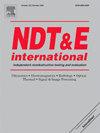高光谱传感在钢中早期腐蚀检测中的可行性
IF 4.1
2区 材料科学
Q1 MATERIALS SCIENCE, CHARACTERIZATION & TESTING
引用次数: 0
摘要
尽管已有数十年的腐蚀减缓实践,但全球钢铁大气腐蚀的成本估计仍占国内生产总值的3 - 4%。广泛用于基础设施建设的钢主要由铁组成,因此极易受到大气腐蚀。游离铁原子与大气中大量存在的水和氧分子发生高度反应。用于腐蚀检测的非接触传感仅限于具有视觉表现的腐蚀。在这项研究中,漫射光谱研究了在视觉表现之前进行腐蚀检测的可行性。随着暴露时间的增加,A36钢试样暴露于腐蚀性碱性介质中。在可见光近红外(VNIR)和近红外(NIR)范围内采集样品的反射光谱。利用x射线衍射证实了视觉声样品中存在早期腐蚀产物。结果表明,与未腐蚀的样品相比,在600-710 nm的近红外波段存在腐蚀,最大变化为97%。研究人员分析了700 nm左右的高光谱图像,发现随着曝光量的增加,腐蚀的速率逐渐增加(2.71 - 12%)。本文章由计算机程序翻译,如有差异,请以英文原文为准。
Feasibilty of hyperspectral sensing for detection of early stages of corrosion in sturcutral steel
The estimated global cost of steel atmospheric corrosion is 3–4 % of the Gross Domestic Product, despite decades of corrosion mitigation practice. Steel, widely used for infrastructure construction, is composed primarily of iron and therefore is extremely vulnerable to atmospheric corrosion. The free iron atoms are highly reactive with water and oxygen molecules abundantly found in the atmosphere. Noncontact sensing for corrosion detectiojn is limited to corrosion with visual manifestation. In this study, diffuse spectroscopy is investigated for the feasibility of corrosion detection before visual manifestation. A36 steel samples were exposed to a corrosive alkaline medium with increasing exposure time. The sample's reflectance spectra were collected in the visual near-infrared (VNIR) and near-infrared (NIR) ranges. The existence of early corrosion products in visual sound samples was verified using X-ray diffraction. Results indicated the presence of corrosion at 600–710 nm in VNIR with a maximum of 97 % change with respect to the uncorroded samples. Hyperspectral images at around 700 nm were analyzed, confirming the presence of corrosion at an incremental rate (2.71–12 %) as exposure increased.
求助全文
通过发布文献求助,成功后即可免费获取论文全文。
去求助
来源期刊

Ndt & E International
工程技术-材料科学:表征与测试
CiteScore
7.20
自引率
9.50%
发文量
121
审稿时长
55 days
期刊介绍:
NDT&E international publishes peer-reviewed results of original research and development in all categories of the fields of nondestructive testing and evaluation including ultrasonics, electromagnetics, radiography, optical and thermal methods. In addition to traditional NDE topics, the emerging technology area of inspection of civil structures and materials is also emphasized. The journal publishes original papers on research and development of new inspection techniques and methods, as well as on novel and innovative applications of established methods. Papers on NDE sensors and their applications both for inspection and process control, as well as papers describing novel NDE systems for structural health monitoring and their performance in industrial settings are also considered. Other regular features include international news, new equipment and a calendar of forthcoming worldwide meetings. This journal is listed in Current Contents.
 求助内容:
求助内容: 应助结果提醒方式:
应助结果提醒方式:


